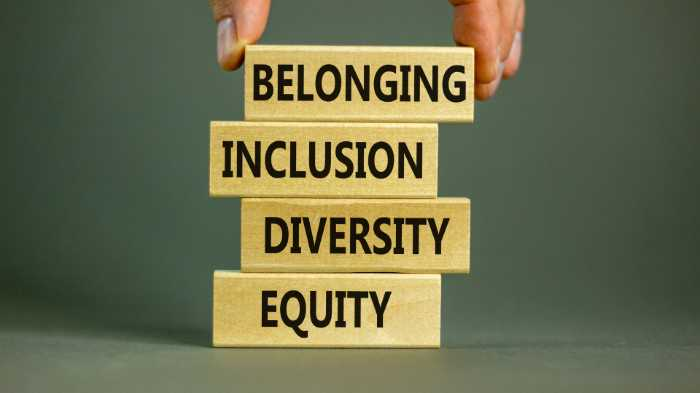
Diversity and inclusion are important concepts that are gaining more attention in the workplace. Many companies are now working to create a more diverse and inclusive environment, but it can be difficult to measure how well they are doing. That is where the diversity and inclusion index comes in. This tool allows businesses to track their progress and see where they need to make improvements. In this blog post, we will discuss what the diversity and inclusion index is, how it works, and why it is important.
- What is the Diversity and Inclusive Index?
- How does the Diversity and Inclusion Index work?
- How can we create diverse and inclusive workplaces?
- What are the major inclusive organizations globally?
- What are some of the key categories of diversity inclusion people development?
- FAQs
What is the Diversity and Inclusive Index?
The Diversity and Inclusive Index (D&I Index) is a measure of the diversity of a company’s workforce. It is calculated by taking the ratio of different groups within the workforce and dividing it by the total number of employees. The D&I Index can be used to compare the diversity of different companies or to track changes in diversity over time.
The index is based on the premise that a more diverse workforce is better able to meet the needs of a variety of customers and clients. Additionally, a diverse workforce can help to foster a culture of inclusion and respect within a company. The D&I Index provides a useful way to gauge a company’s commitment to diversity and inclusion and can be used as a tool to drive change within an organization.
How does the Diversity and Inclusion Index work?

The Diversity and Inclusion Index is a tool used to measure an organization’s commitment to diversity and inclusion. The index measures relative performance based on four pillars: workforce diversity, workforce inclusion, corporate governance, and supplier diversity. To calculate the index, organizations must first collect data on each of the four pillars.
They then use this data to generate a score for each pillar. The final score is an average of the scores for all four pillars. The Diversity and Inclusion Index can be used to benchmark an organization’s progress on diversity and inclusion, as well as to compare it against the global financial community. By using the index, organizations can identify areas where they need to improve their commitment to diversity and inclusion.
What is the diversity best practices inclusion index?
The Diversity Best Practices Inclusion Index is a research-based tool that organizations can use to self-assess their level of inclusion. The index consists of five subscales: Engagement, Access, Equity, Respect, and Advancement. Each subscale contains a set of items that assesses an organization’s progress in that area.
The Engagement subscale, for example, includes items such as “employees are given opportunities to contribute their ideas and opinions” and “employees feel comfortable expressing their views.” Organizations can use the index to benchmark their current level of inclusion and identify areas for improvement. By increasing their level of inclusion, organizations can create a more diverse and inclusive workplace that benefits both employees and the organization as a whole.
How can we create diverse and inclusive workplaces?

Anyone who has ever applied for a job knows that the process can be daunting. In addition to meeting the qualifications for the position, you also have to make sure that you are a good fit for the company culture.
This can be especially challenging for people from underrepresented groups, who may feel like they have to choose between being true to themselves and fitting in at work. Fortunately, there are 5 steps that companies can take to create workplaces that are more diverse and inclusive.
1. Develop policies and practices that support employees of all backgrounds
One way to do this is to develop policies and practices that support employees of all backgrounds. This might include offering flexible work arrangements, providing training on cultural competence, or establishing employee resource groups. By taking these steps, companies can create workplaces that are truly welcoming to everyone.
2. Assess your current workforce diversity
Achieving a diverse and inclusive workplace is a multi-step process, and the first step is to assess your current workforce diversity. This will help you identify policies and procedures where your company may need to improve. To get started, take a look at the makeup of your workforce. How many employees come from different racial or ethnic backgrounds? Do you have a good mix of men and women?
Once you have an idea of the current state of diversity within your company, you can start to set goals for improvement. You may also want to consider conducting an unconscious bias test to identify any potential areas of prejudice. By taking these steps, you can create a more diverse and inclusive workplace for all.
3. Analyze your recruitment and selection processes
The second step in creating diverse and inclusive workplaces is to analyze your recruitment and selection processes. Make sure that these processes are free from bias and that they attract a diverse range of candidates. This will help to ensure that your workplace is truly welcoming to everyone. By taking this step, you can help to create an environment where everyone feels valued and respected.
Diversity and inclusion are essential for a thriving workplace, so make sure that your recruitment and selection processes reflect this commitment 4. Implement training and development programs that promote diversity and inclusion. These programs should be designed to educate employees about different cultures and how to work together effectively.
4. Evaluate your progress on a regular basis
As part of your commitment to creating a diverse and inclusive workplace, it’s important to evaluate your progress on a regular basis. This will help you fine-tune your efforts and ensure that you’re making the most impact. When evaluating your progress, consider both quantitative and qualitative data.
Look at things like the composition of your workforce (including demographics like race, gender, and sexuality), as well as indicators of inclusion such as retention rates, employee satisfaction, and the number of complaints of discrimination or harassment. By regularly assessing your progress, you can make sure that you’re moving in the right direction and making a real difference for your employees.
5. Be patient
Making your workplace more diverse and inclusive is a long-term process, so it’s important to be patient. Remember that Rome wasn’t built in a day, and neither will your ideal workplace. Creating lasting change takes time, but it’s worth the effort. So take the first step today and start working towards a more diverse and inclusive workplace.
With these five steps, you can create a workplace that is truly welcoming to everyone.
What are the major inclusive organizations globally?

The Diversity and Inclusion Index ranks organizations on their inclusion metrics and practices. The Global Inclusion Index assesses the inclusive cultures of companies around the world. To be inclusive, companies must create an environment where all employees feel welcome, respected, and valued. This requires more than just implementing policies; it also requires changing mindsets and behavior.
Inclusive companies are those that understand the business case for diversity and are committed to making inclusion a top priority. There are a number of inclusive organizations globally that promote diversity and inclusion in the workplace. Some of these organizations include:
- The National Association for the Advancement of Colored People (NAACP)
- The Urban League
- Lambda Legal
- The National LGBTQ Task Force
- GLAAD
Inclusive organizations globally are working to promote diversity and inclusion in the workplace by advocating for equal opportunity for all employees, regardless of their protected status.
What are some of the key categories of diversity inclusion people development?
There are four key categories of diversity inclusion people development: cognitive, affective, physical, and social.
- Cognitive diversity includes things like different ways of thinking and learning. It can be helpful to have a mix of people with different thinking styles on a team so that all sides of an issue can be considered.
- Affective diversity refers to differences in how people feel about things. It’s important to have a mix of people with different emotional reactions to situations so that all possible outcomes can be considered.
- Physical diversity encompasses things like age, gender, race, and disability. It’s important to have a mix of people with different physical characteristics on a team so that all members of the population can be represented.
- Social diversity includes things like culture, religion, and socioeconomic status. It’s important to have a mix of people with different social backgrounds on a team so that all voices can be heard.
What is the impact of Thomson Reuters on workplace diversity and inclusion?
Thomson Reuters Corporation is a leading provider of news and information to the global business community. The company has a long history of commitment to diversity and inclusion in the workplace, and its Diversity & Inclusion Initiative is widely recognized as one of the most comprehensive and effective programs in the industry.
The Initiative includes a number of key components, such as:
- A focus on recruiting, retaining, and promoting diverse talent;
- An emphasis on creating an inclusive culture where all employees feel valued and respected;
- A commitment to diversity and inclusion training for all employees;
- An ongoing dialogue about diversity and inclusion issues at all levels of the organization.
The impact of Thomson Reuters’ Diversity & Inclusion Initiative has been significant. The company has been recognized as a top employer for diverse talent, and its employee satisfaction scores consistently rank above average. Additionally, the company has seen a decrease in turnover rates among employees from underrepresented groups.
FAQs

Define diverse and inclusive workplaces
Diverse and inclusive workplaces are organizations that have policies, procedures, and programs in place to promote diversity and inclusion within their workforce. This includes organizations that are committed to equal opportunity for all employees, regardless of race, color, religion, sex, national origin, disability status, veteran status, sexual orientation, gender identity or expression, or any other protected characteristic.
How do financial professionals screen companies?
Financial professionals screen companies in a variety of ways. They may review financial statements, assess market conditions, or speak with company management. By doing so, they can get a better sense of a company’s strengths and weaknesses. This information can then be used as an investment tool to make decisions.
How do news controversies affect Diversity and Inclusion?
The news is full of stories about controversies related to diversity and inclusion. From lawsuits alleging discrimination to high-profile firings for offensive comments, these stories can have a significant impact on the way companies view and approach diversity and inclusion. In some cases, news controversies can lead to changes in corporate policy, such as new hiring practices or increased training for employees. In other cases, they may simply serve as a reminder of the importance of creating an inclusive environment. Either way, it is clear that news controversies about diversity and inclusion can have a significant impact on the workplace.
What are inclusion practices?
Inclusion practices are the policies and procedures that an organization puts in place to ensure that everyone feels welcome, respected, and valued.
What are inclusion metrics?
Inclusion metrics are the measures used to track progress toward organizational goals related to diversity and inclusion. Generally, these measures fall into three categories: demographics, attitudes, and behaviors.
What is underlying diversity?
Underlying diversity is the range of characteristics that make people unique. It includes both visible and non-visible factors such as race, ethnicity, gender, age, disability, sexual orientation, and religion.
Who are financial professionals?
Financial professionals are those who work in the finance industry, including bankers, stockbrokers, and financial planners.
What is vast data?
Vast data refers to the large amounts of information that organizations have at their disposal. This data can be used to identify opportunities for increasing inclusion and improving equity.
What is corporate responsibility?
Corporate responsibility is an organization’s commitment to operating in a socially and environmentally responsible manner. This includes creating inclusive workplaces as well as taking steps to reduce their impact on the environment.

Dean Emerick is a curator on sustainability issues with ESG The Report, an online resource for SMEs and Investment professionals focusing on ESG principles. Their primary goal is to help middle-market companies automate Impact Reporting with ESG Software. Leveraging the power of AI, machine learning, and AWS to transition to a sustainable business model. Serving clients in the United States, Canada, UK, Europe, and the global community. If you want to get started, don’t forget to Get the Checklist! ✅
